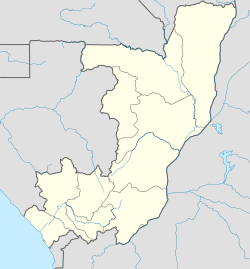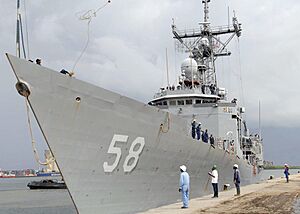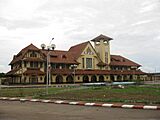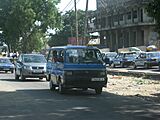Pointe-Noire facts for kids
Quick facts for kids
Pointe-Noire
Njinji
|
|||
|---|---|---|---|
|
Department
|
|||

Pointe-Noire
|
|||
|
|||
| Motto(s):
Labor improbus omnia vincit
|
|||
| Country | |||
| Department | Pointe-Noire Department | ||
| Commune | Pointe-Noire | ||
| Founded | 1883 | ||
| Area | |||
| • Total | 2,134 km2 (824 sq mi) | ||
| Elevation | 14 m (46 ft) | ||
| Population
(2023 census)
|
|||
| • Total | 1,420,612 | ||
| • Density | 665.70/km2 (1,724.2/sq mi) | ||
| • Official language | French | ||
| • National language | Kituba language | ||
| Area code(s) | 242 | ||
| HDI (2021) | 0.614 · medium · 2nd of 12 | ||
Pointe-Noire is a major city in the Republic of the Congo. It's the second largest city, right after the capital, Brazzaville. Pointe-Noire is also its own special area, called a department and a commune, since 2002.
This city is located on a piece of land that sticks out into the Atlantic Ocean. It's a very important place for business and trade in the country. In 2023, about 1.4 million people lived there.
Contents
- What is the Coat of Arms of Pointe-Noire?
- How is Pointe-Noire Governed?
- The History of Pointe-Noire
- What is the Economy of Pointe-Noire Like?
- Education in Pointe-Noire
- Universities in Pointe-Noire
- How do People Get Around in Pointe-Noire?
- Places of Worship
- What is the Climate Like?
- Sports in Pointe-Noire
- Sister Cities
- Famous People from Pointe-Noire
- Images for kids
- See also
What is the Coat of Arms of Pointe-Noire?
The coat of arms for Pointe-Noire has a special design. It shows a gold background with a sandy point. There are also two silver oars with red handles. These oars and the point seem to come out of a blue sea with three wavy silver lines.
How is Pointe-Noire Governed?
Pointe-Noire is a city divided into six main areas, like neighborhoods, called arrondissements:
- Lumumba: This is the oldest part of the city. It's where the main government offices and businesses are located.
- Mvoumvou
- Tié-Tié
- Loandjili
- Mongo-Mpoukou
- Ngoyo
Pointe-Noire is also a larger area, a department. This department includes the city itself and, since 2011, a district called Tchiamba-Nzassi.
The History of Pointe-Noire
How did Pointe-Noire get its name?
The name Pointe-Noire means "Black Point" in French. It was named by Portuguese navigators in 1484. They saw a dark block of rocks on the coastline. This "Black Point" became a famous landmark for ships.
From Fishing Village to City
Pointe-Noire started as a small fishing village in 1883. This was after the French made a deal with the local people, the Loangos.
In 1910, a large French colony called French Equatorial Africa was formed. French companies wanted to use the resources from the Middle Congo (which is now the Republic of the Congo). They needed a way to transport goods from Brazzaville to the Atlantic coast. Brazzaville was at the end of the Congo River, but rapids made it impossible for ships to go further.
So, they decided to build a railway. They chose Pointe-Noire as the end point for the railway because it was a good spot for a deep-sea port. In 1923, it was officially chosen as the start of the Congo-Ocean Railway.
Growth and Development
By 1927, Pointe-Noire had about 3,000 people and got clean drinking water. An airport was built in 1932. In 1934, the Congo-Ocean Railway officially opened. The first hospital was built in 1936, and a bank opened its first branch. In 1942, the Pointe-Noire Harbour opened, making the city a very important seaport.
By 1950, Pointe-Noire had grown to 20,000 people. It became the capital of the Middle Congo. In 1957, the Middle Congo became the Republic of Congo.
Modern Times and Oil
Pointe-Noire kept growing and was a very modern city by 1960, when Congo became independent. Around 1980, oil was discovered nearby. This brought more people and companies like Elf Aquitaine to the city. The population quickly grew, reaching 360,000 by 1994.
In the late 1990s, civil wars in the country caused many people to move to Pointe-Noire for safety. This made the city's population grow to over 1 million people.
Recently, the government has planned to build a new port for large resources at Point Indienne, about 30 kilometers north of Pointe-Noire.
What is the Economy of Pointe-Noire Like?
Pointe-Noire is the main center for the oil industry in the Republic of Congo. Congo is one of the biggest oil producers in Central Africa. The French company Elf Aquitaine has been a major player in the oil industry here since oil was found around 1980.
The city is also known for its fishing industry. However, there are sometimes problems between fishing and oil development. People say that too many fish are being caught in the local waters.
In the past, Pointe-Noire also had a potash mining operation. This led to the building of a special dock, which is now closed.
Education in Pointe-Noire
Pointe-Noire has several schools and universities.
- Lycée Français Charlemagne is a French international school for kids from primary to secondary grades.
- Connie's Academy is a British international school for children aged 0 to 18.
There are also many places for higher education:
- École Supérieure de Technologie du Littoral (for technology)
- École supérieure de commerce et de gestion (for business)
- Institut UCAC-ICAM (for engineering)
- Centre d’éducation, de formation et d’apprentissage en mécanique auto (for automotive engineering)
- The Higher Institute of Technology of Central Africa has a campus here.
Universities in Pointe-Noire
Because the Congolese government wants to spread out education, Pointe-Noire has seen new universities open. The city has several private colleges and universities:
- The University of Loango offers programs in law, management, and commerce.
- The Ecole Africaine de Développement in Pointe-Noire has programs in science and technology.
- Ecole Superieure of Commerce and Industry of Congo offers Bachelor's degree courses.
How do People Get Around in Pointe-Noire?
Airports and Railways
Pointe-Noire has the Agostinho-Neto International Airport. As of August 2023, you could fly directly to many cities from here, including Abidjan, Addis Ababa, Brazzaville, and Paris. It's the second busiest airport in the country.
Pointe-Noire is also the end point of the Congo-Ocean Railway. The railway station building is quite famous. As of 2014, a train service called La Gazelle ran every other day to Brazzaville.
Because the city has grown so much, there are now other railway stations within Pointe-Noire, like Tié-Tié Railway Station and Ngondji Railway Station.
Train Accidents
On June 22, 2010, a train leaving Pointe-Noire had an accident, and many passengers died. The French built this railway between 1921 and 1934 when they ruled Congo.
Public Transport
Pointe-Noire has a network of taxi-buses that travel all over the city.
Places of Worship
Most of the places of worship in Pointe-Noire are Christian churches. These include the Roman Catholic Diocese of Pointe-Noire (part of the Catholic Church), the Evangelical Church of Congo, and Assemblies of God.
What is the Climate Like?
Pointe-Noire has a tropical savanna climate. This means it has a wet season and a dry season. The wet season lasts from October to April, and the dry season is the other five months.
The city gets about 1000 millimeters (about 39 inches) of rain each year. Temperatures are a bit cooler during the dry season, around 24 degrees Celsius (75 degrees Fahrenheit). In the wet season, the average temperature is about 28 degrees Celsius (82 degrees Fahrenheit).
| Climate data for Pointe-Noire (1991-2020) | |||||||||||||
|---|---|---|---|---|---|---|---|---|---|---|---|---|---|
| Month | Jan | Feb | Mar | Apr | May | Jun | Jul | Aug | Sep | Oct | Nov | Dec | Year |
| Mean daily maximum °C (°F) | 30.3 (86.5) |
31.0 (87.8) |
31.4 (88.5) |
31.1 (88.0) |
29.7 (85.5) |
27.4 (81.3) |
26.0 (78.8) |
26.1 (79.0) |
27.1 (80.8) |
28.7 (83.7) |
29.5 (85.1) |
29.7 (85.5) |
29.0 (84.2) |
| Daily mean °C (°F) | 26.9 (80.4) |
27.3 (81.1) |
27.6 (81.7) |
27.3 (81.1) |
26.4 (79.5) |
24.1 (75.4) |
22.5 (72.5) |
22.7 (72.9) |
24.1 (75.4) |
25.8 (78.4) |
26.4 (79.5) |
26.5 (79.7) |
25.6 (78.1) |
| Mean daily minimum °C (°F) | 24.0 (75.2) |
24.1 (75.4) |
24.3 (75.7) |
24.2 (75.6) |
23.7 (74.7) |
21.0 (69.8) |
20.1 (68.2) |
20.4 (68.7) |
22.1 (71.8) |
— | 23.9 (75.0) |
23.8 (74.8) |
23.4 (74.1) |
| Average precipitation mm (inches) | 180.3 (7.10) |
225.4 (8.87) |
193.4 (7.61) |
134.1 (5.28) |
55.5 (2.19) |
2.2 (0.09) |
1.0 (0.04) |
4.2 (0.17) |
16.7 (0.66) |
104.5 (4.11) |
201.6 (7.94) |
185.5 (7.30) |
1,304.4 (51.36) |
| Source: NOAA | |||||||||||||
Sports in Pointe-Noire
Some of the football teams in Pointe-Noire are Association Sportive des Cheminots and Jeunesse Sportive les Bougainvillées.
Sister Cities
Pointe-Noire has "sister city" relationships with other cities around the world. This means they share cultural and economic ties.
 Dalian, China
Dalian, China New Orleans, United States
New Orleans, United States Suzhou, China
Suzhou, China
Famous People from Pointe-Noire
- Delvin N'Dinga, a footballer
- Junior Etou (born 1994), a Congolese basketball player
- Ghislaine Sathoud, a writer who focuses on women's rights
- Alain Mabanckou (born 1966), a writer
Images for kids
See also
 In Spanish: Pointe-Noire (República del Congo) para niños
In Spanish: Pointe-Noire (República del Congo) para niños










